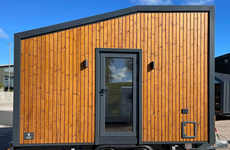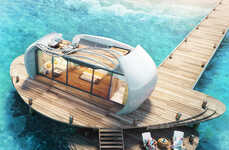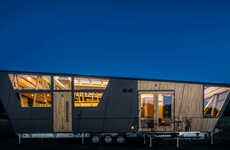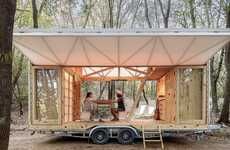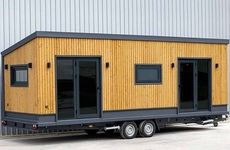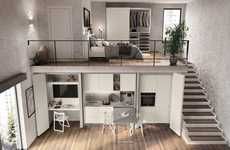
Mo. Ho. Mobile Housing Allows Your Apartment to Move with You
Amelia Roblin — May 7, 2011 — Eco
The world will continue to feel a whole lot smaller if the Mo. Ho. Mobile Housing project gets off the ground. Engineering students from Rome, Italy, including Andrea Bonamore, Lorenzo Carrino, Riccardo Franchellucci and Lorenzo Bramonti, have come together to propose an urban plan that incorporates a system of universal modular residences. The residences will be stackable, and able to form apartment buildings in major international metropolises.
An owner of one of these condominium modules may decide to move from Hong Kong to New York city, and ship this dwelling with him. The 400m-tall towers can grow and shrink depending on urban density and space demands, and such skyscrapers can even be formed atop existing structures. With standard sizes and shapes for one- to three-bedroom units, the Mo. Ho. Mobile Housing proposal will further unify the cities of the world.
An owner of one of these condominium modules may decide to move from Hong Kong to New York city, and ship this dwelling with him. The 400m-tall towers can grow and shrink depending on urban density and space demands, and such skyscrapers can even be formed atop existing structures. With standard sizes and shapes for one- to three-bedroom units, the Mo. Ho. Mobile Housing proposal will further unify the cities of the world.
Trend Themes
1. Modular Residences - The trend of universal modular residences allows for easy transportation and flexibility, making it disruptively innovative for urban living.
2. Stackable Building - The trend of stackable buildings enables the creation of apartment complexes with the ability to grow or shrink based on urban density and demands, presenting disruptive innovation in urban planning and construction.
3. Shrinking Skyscrapers - The trend of skyscrapers that can shrink or expand offers an innovative solution to maximize space utilization in major international metropolises, disrupting traditional urban development.
Industry Implications
1. Real Estate - The real estate industry can leverage the trend of modular residences and stackable building to offer flexible and mobile housing solutions, opening up new disruptive business opportunities.
2. Urban Planning - The trend of modular, stackable buildings provides urban planners with the opportunity to design flexible and adaptable spaces, revolutionizing how cities are developed.
3. Architecture and Construction - Architects and construction firms can capitalize on the trend of shrinking skyscrapers to create innovative structures that can adapt to changing urban landscapes, introducing disruptive advancements in building design and construction methods.
5.7
Score
Popularity
Activity
Freshness


